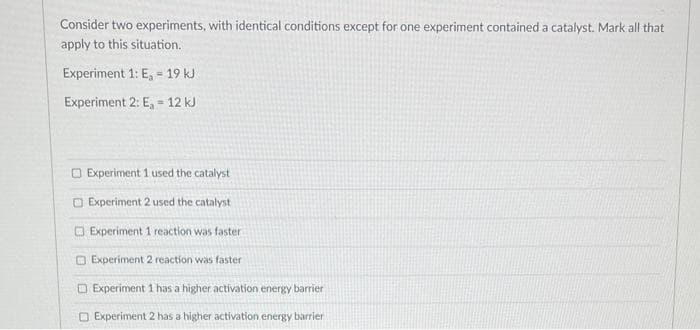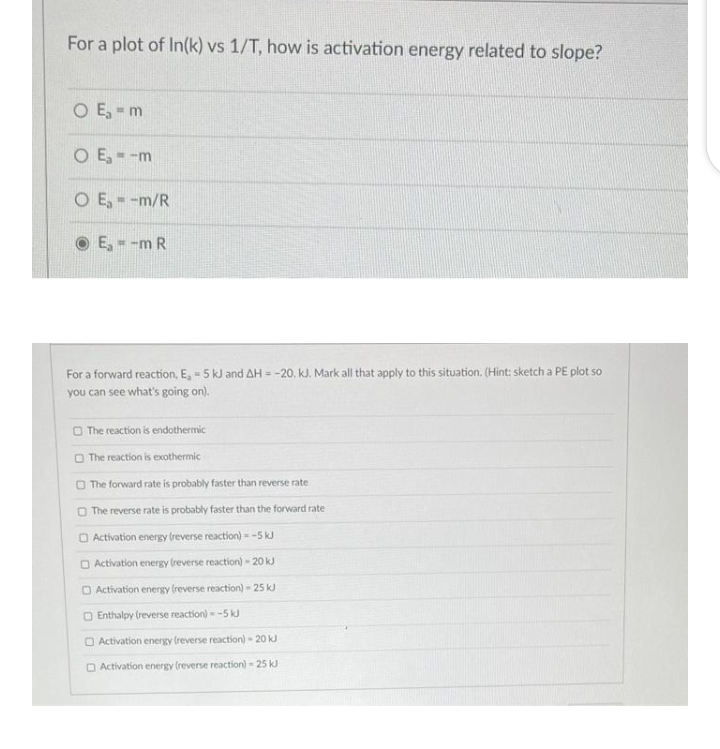Consider two experiments, with identical conditions except for one experiment contained a catalyst. Mark all that apply to this situation. Experiment 1: E, - 19 kJ = Experiment 2: E, 12 kJ Experiment 1 used the catalyst Experiment 2 used the catalyst Experiment 1 reaction was faster Experiment 2 reaction was faster Experiment 1 has a higher activation energy barrier Experiment 2 has a higher activation energy barrier
Consider two experiments, with identical conditions except for one experiment contained a catalyst. Mark all that apply to this situation. Experiment 1: E, - 19 kJ = Experiment 2: E, 12 kJ Experiment 1 used the catalyst Experiment 2 used the catalyst Experiment 1 reaction was faster Experiment 2 reaction was faster Experiment 1 has a higher activation energy barrier Experiment 2 has a higher activation energy barrier
Chemistry: Principles and Reactions
8th Edition
ISBN:9781305079373
Author:William L. Masterton, Cecile N. Hurley
Publisher:William L. Masterton, Cecile N. Hurley
Chapter11: Rate Of Reaction
Section: Chapter Questions
Problem 71QAP: For a certain reaction, Ea is 135 kJ and H=45 kJ. In the presence of a catalyst, the activation...
Related questions
Question
Give the all answer

Transcribed Image Text:Consider two experiments, with identical conditions except for one experiment contained a catalyst. Mark all that
apply to this situation.
Experiment 1: E = 19 kJ
Experiment 2: E,- 12 kJ
Experiment 1 used the catalyst
Experiment 2 used the catalyst
Experiment 1 reaction was faster
Experiment 2 reaction was faster
Experiment 1 has a higher activation energy barrier
Experiment 2 has a higher activation energy barrier

Transcribed Image Text:For a plot of In(k) vs 1/T, how is activation energy related to slope?
O E, m
O E₂ --m
O E₂ = -m/R
E = -m R
For a forward reaction, E, - 5 kJ and AH = -20. kJ. Mark all that apply to this situation. (Hint: sketch a PE plot so
you can see what's going on).
The reaction is endothermic
The reaction is exothermic
The forward rate is probably faster than reverse rate
The reverse rate is probably faster than the forward rate
Activation energy (reverse reaction) = -5 kJ
Activation energy (reverse reaction) - 20 kJ
Activation energy (reverse reaction) - 25 kJ
O Enthalpy (reverse reaction) = -5 kJ
Activation energy (reverse reaction) - 20 kJ
D Activation energy (reverse reaction) - 25 kJ
Expert Solution
This question has been solved!
Explore an expertly crafted, step-by-step solution for a thorough understanding of key concepts.
Step by step
Solved in 3 steps

Knowledge Booster
Learn more about
Need a deep-dive on the concept behind this application? Look no further. Learn more about this topic, chemistry and related others by exploring similar questions and additional content below.Recommended textbooks for you

Chemistry: Principles and Reactions
Chemistry
ISBN:
9781305079373
Author:
William L. Masterton, Cecile N. Hurley
Publisher:
Cengage Learning

Introductory Chemistry: A Foundation
Chemistry
ISBN:
9781337399425
Author:
Steven S. Zumdahl, Donald J. DeCoste
Publisher:
Cengage Learning

Chemistry: The Molecular Science
Chemistry
ISBN:
9781285199047
Author:
John W. Moore, Conrad L. Stanitski
Publisher:
Cengage Learning

Chemistry: Principles and Reactions
Chemistry
ISBN:
9781305079373
Author:
William L. Masterton, Cecile N. Hurley
Publisher:
Cengage Learning

Introductory Chemistry: A Foundation
Chemistry
ISBN:
9781337399425
Author:
Steven S. Zumdahl, Donald J. DeCoste
Publisher:
Cengage Learning

Chemistry: The Molecular Science
Chemistry
ISBN:
9781285199047
Author:
John W. Moore, Conrad L. Stanitski
Publisher:
Cengage Learning

Chemistry by OpenStax (2015-05-04)
Chemistry
ISBN:
9781938168390
Author:
Klaus Theopold, Richard H Langley, Paul Flowers, William R. Robinson, Mark Blaser
Publisher:
OpenStax

Chemistry: Principles and Practice
Chemistry
ISBN:
9780534420123
Author:
Daniel L. Reger, Scott R. Goode, David W. Ball, Edward Mercer
Publisher:
Cengage Learning

Chemistry for Engineering Students
Chemistry
ISBN:
9781337398909
Author:
Lawrence S. Brown, Tom Holme
Publisher:
Cengage Learning